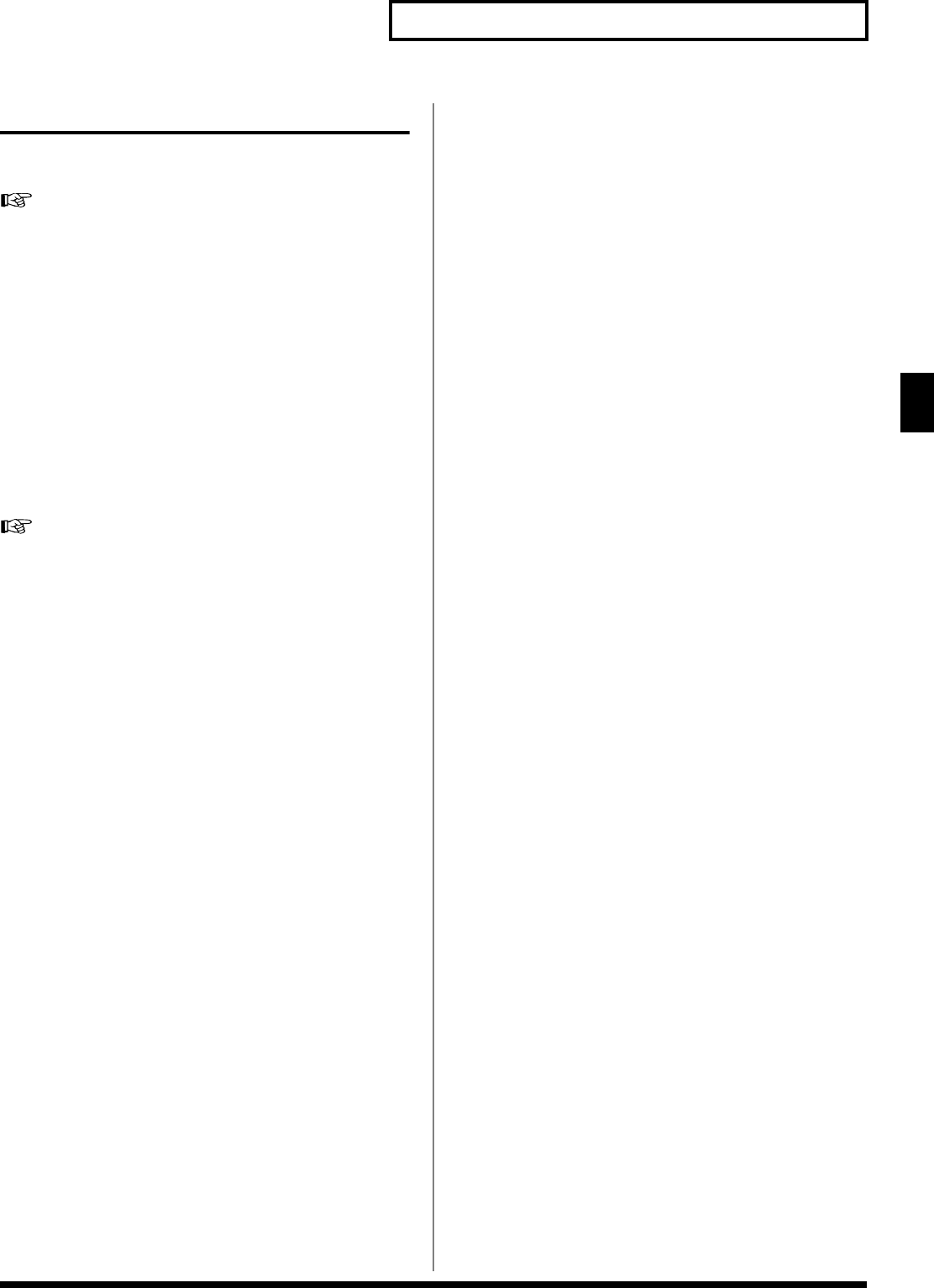
189
Settings Common to All Modes (System Function)
Settings Common to All Modes (System Function)
Functions of System Parameters
This section explains what the different System parameters do, and
also how these parameters are organized.
For details on the setting, refer to
“How to Make the System
Function Settings”
(p. 188).
Pedal/D Beam
D Beam Sens (D Beam Sensitivity)
This sets the D Beam controller's sensitivity. The higher the value set,
the more readily the D Beam Controller goes to into errect.
Value:
0–127
Control Pedal Assign
This specifies the function of each pedal connected to the PEDAL
CONTROL jacks.
Value
CC01–31, 33–95:
Controller numbers 1–31, 33–95
For details on control change messages, refer to
“MIDI
Implementation”
(Parameter List).
BEND UP:
The pitch will rise in semitone steps (maximum 4 octaves)
each time you press the pedal.
BEND DOWN:
The pitch will fall in semitone steps (maximum 4
octaves) each time you press the pedal.
AFTERTOUCH:
Aftertouch
OCT UP:
Each pedal press raises the key range in octave steps (up to
3 octaves higher).
OCT DOWN:
Each pedal press lowers the key range in octave steps
(up to 3 octaves lower).
START/STOP:
The sequencer will start/stop.
PUNCH IN/OUT:
Manual punch-in/out recording will start/stop.
TAP TEMPO:
Tap tempo (a tempo specified by the interval at which
you press the pedal).
PROG UP:
The next sound number will be selected.
PROG DOWN:
The previous sound number will be selected.
FAVORITE UP:
The favorite sound of the next number or bank will
be selected.
FAVORITE DOWN:
The favorite sound of the previous number or
bank will be selected.
ARP/RHY SW:
Switches the Arpeggio/Rhythm function on/off.
RHY START/STOP:
Switch Rhythm pattern playback on/off.
CHORD SW:
Chord function on/off.
Control Pedal Polarity
Selects the polarity of the pedal. On some pedals, the electrical signal
output by the pedal when it is pressed or released is the opposite of
other pedals. If your pedal has an effect opposite of what you expect,
set this parameter to “REVERSE.” If you are using a Roland pedal
(that has no polarity switch), set this parameter to “STANDARD.”
Value:
STANDARD, REVERSE
Hold Pedal Polarity
Select the polarity of the Hold pedal. On some pedals, the electrical
signal output by the pedal when it is pressed or released is the
opposite of other pedals. If your pedal has an effect opposite of what
you expect, set this parameter to “REVERSE.” If you are using a
Roland pedal (that has no polarity switch), set this parameter to
“STANDARD.”
Range
: STANDARD, REVERSE
Continuous Hold Pedal
This setting determines whether the HOLD PEDAL jack will provide
support for half-pedaling (ON), or not (OFF). When this is set to support
use of half-pedaling techniques, you can then connect an optional
expression pedal (DP-8, etc.), and employ pedal work to achieve even
finer control in performances in which piano tones are used.
Value:
OFF, ON
Keyboard
Keyboard Velocity
Specifies the velocity value that will be transmitted when you play
the keyboard. If you want actual keyboard velocity to be
transmitted, set this to “REAL.” If you want a fixed velocity value to
be transmitted regardless of how you play, specify the desired value
(1–127).
Value:
REAL, 1–127
Keyboard Sens (Keyboard Sensitivity)
Adjusts the keyboard’s touch.
Value
LIGHT:
Light weight synthesizer keyboard like
MEDIUM:
Standard
HEAVY:
Acoustic piano simulation
Aftertouch Sens (Aftertouch Sensitivity)
Specifies the Aftertouch sensitivity. Higher values will allow
Aftertouch to be applied more easily. Normally you will leave this at
“100.”
Value:
0–100%
Reference_e.book 189 ページ 2003年7月14日 月曜日 午後3時25分


















